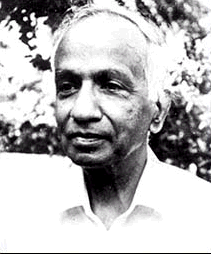 October 1910 in the Lahore
province of erstwhile India, Subrahmanyan Chandrashekhar was awarded the Nobel
Prize for Physics in 1983 for propounding the widely accepted theory on the
later evolutionary stages of massive stars, which he shared with William A.
Fowler.
October 1910 in the Lahore
province of erstwhile India, Subrahmanyan Chandrashekhar was awarded the Nobel
Prize for Physics in 1983 for propounding the widely accepted theory on the
later evolutionary stages of massive stars, which he shared with William A.
Fowler.Chandrashekhar's uncle, Sir Chandrashekhar Venkata Raman, had won the Nobel Prize for Physics in 1930. So being an outstanding physicist came naturally to Chandrashekhar. A brilliant product of the Presidency College and the University of Madras, Chandrashekhar furthered his academic pursuits at the Trinity College, Cambridge. He also held a position at Trinity from 1933 to 1937.
Upto the early 1930's, it was common scientific belief that stars lose all their energy after exhausting their hydrogen reserves. Once all the hydrogen is converted to helium, they contract under their own gravity to become white dwarf Stars. These white dwarfs are about the size of the planet Earth and their constituting atoms and nuclei are compressed to an extremely high dense state. The Chandrashekhar limit, expounded by Chandrashekhar, established that stars having more than 1.44 times the mass of the sun do not become white dwarfs. Instead they continue to collapse under their own gravity and after a supernova explosion, become neutron stars. Even bigger stars continue to collapse and become Black Holes - a star so constricted under its gravitational pull that it doesn't even let light pass through. Chandrashekhar's theory provided a deeper understanding of Supernova explosions, Neutron stars and Black Holes.
Chandrashekhar became the Morton D Hull Distinguished Service Professor of Astrophysics in 1952 at the University of Chicago where he had joined as an Assistant Professor of Astrophysics in 1938. He became an American citizen in 1953.
He was awarded the Gold Medal of the Royal Astronomical Society in 1953 and the Royal Medal of the Royal Society in 1962. He also authored a number of books, chief among which are 'An Introduction to the Study of Stellar Structure' (1939), 'Principles of Stellar Dynamics' (1942), 'Radiative Transfer' (1950), 'Hydrodynamic and Hydromagnetic Stability' (1961) and 'Truth and Beauty: Aesthetics and Motivations in Science' (1987).
Chandrashekhar conducted invaluable research on the transfer of energy by radiation in stellar atmospheres and convection on the solar surface. In his book 'The Mathematical Theory of Black Holes', he tried to apply this theory to the analysis of the origin and nature of Black Holes.
The country lost this brilliant gem on 21 August 1995 in Chicago, Illinois, USA.